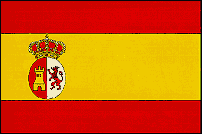 Royal Colors of Spain, 1785-1931 |
|
 Royal Colors of Spain, 1785-1931 |
|
Spain was comparatively late in calling for the universal issue of marked buttons to the component elements of its military establishment. While the French had ordered the issue of unit-specific uniform buttons in 1762, the British in 1768, and the United States from the outset of its war for colonial independence in 1775-1776, it was not until 1791 that marked buttons began to be described and designated for issue to a number of Spanish peninsular infantry units and March of 1795 that a royal decree appeared which mandated the issue of marked buttons to and for all of Spain's military forces.
While the year 1795 serves as a useful benchmark for the universally mandated appearance of marked Spanish military uniform buttons, it should be noted that the actual use of these elements of insignia both predated and postdated that year. In addition to the infantry regiments mentioned above, the Spanish Royal Navy—the crown jewel of Spain's military establishment—may have been using "anchor buttons" as early as the 1780s and had separate regulations calling for the use of marked buttons in 1793.
It is also highly probable that many units, particularly those comprising Spain's far-flung provincial forces, did not come into immediate conformity with the 1795 decree. The first regulations specifying a button device for the Spanish Royal Artillery, for example, did not appear until August 1797, and the first unit-specific button devices for the Royal Corps of Engineers and the Regiment of Sappers and Miners did not appear until 1803. Supply shortages and a predicable desire to exhaust existing stores of uniform goods prior to issuing new uniforms or the buttons to adorn them also contributed to a probable delay of the universal appearance of marked military uniform buttons by all Spanish units authorized to wear them for several years.
Evidence currently available promotes the probability that the issue and use of marked Spanish military uniform buttons occurred gradually over a period of several years prior to the royal decree of 1795, and that said decree served to globally prescribe, rather than to initiate, the universal application of an already ongoing process within the Spanish military establishment. This decree's most significant short-term effect, then, would have been to ensure that all of Spain's royal, regular, and provincial forces would fall into conformity with a practice that was already being manifested on a limited scale by some of that nation's servicemen. At this moment, data regarding the chronology of and manner in which Spain's military forces achieved uniformity in the issue of marked uniform buttons remain at least partially inferential and incomplete. As additional information becomes available, this page will be updated and amended.
It is relatively safe to assume that all but a very small number of Spain's regular and full-time provincial forces were wearing marked buttons by 1800. Meanwhile, surplus and obsolete supplies of uniforms, accouterments, arms and other accessories (such as the unmarked, drilled shank buttons that had already seen use for nearly a century) remained in use by Spain's many local, "urban" militia units.
The buttons shown below represent a cross section of the typologies worn by Spain's royal, regular, and professional veteran provincial forces in Las Floridas. Buttons and other insignia attributed to use by the Louisiana Regiment of Infantry—Spain's provincial garrison unit in both Louisiana and Florida—are included in a separate and singularly dedicated section of this online exhibition.
Spanish marked military uniform buttons, like the units that wore them, can be divided into three broad categories: Royal forces, like the Royal Navy and Royal Engineers, which comprised permanent elements of the Spanish royal military establishment and whose insignia always include the corona real (royal crown) of Spain; regular forces, comprised of full-time units raised in Spain and its allied European states; and fixed provincial forces (Tropas Veteranas), like the Regimiento de infantería de Luisiana mentioned above, which were full-time professional veteran units raised for service in Spain's overseas provinces and, after having been initially raised with peninsular Spanish recruits, were usually manned primarily by inhabitants of the geographical regions in which those units were assigned to serve. The examples shown here will be organized and arranged within these categories.
An "Other Button Typologies" section has been added at the end of this page to accommodate marked button forms which presently defy placement within any of the above mentioned categories or whose interpretation is currently inspecific. This section may be broadened or contracted as more examples come to light or as others become more specifically interpreted and identified.
NOTE: All illustrations include 1/4" gridded backgrounds.
SECTION ONE: ROYAL FORCES
While representatives of the Royal Artillery, Royal Sappers and Miners, Royal Engineers, Royal Navy, and Royal Marine Infantry and Artillery served in the study region, only button examples worn by the latter two branches of service are known at this time to have been recovered in that region. Examples of other branches presented here are from Spain and are included for interpretive and illustrative purposes. "Royal" forces' insignia (including, when they appeared, marked buttons) characteristically included the Spanish royal crown surmounting unit-specific words or designs.
ROYAL CORPS OF ARTILLERY, 1797-1802 First organized in 1710, the Spanish Royal Corps of Artillery wore plain buttons until a royal order of 18 August 1797 called for the use of a unit-specific button device for the corps. This first device consisted of a royal crown surmounting crossed cannons under which appeared a stack of cannon balls. The small cuff/gaiter button of this pattern exhibited here is of cast brass to which a conventional looped wire shank/eye has been brazed. This artillery button pattern was changed in 1802, but the distinctive crown, crossed cannons, and stack of cannon balls emblem which it bore was restored to the Spanish artillery service in 1840 (on the deeply convex military buttons used during this later period) and continued in use thereafter. Engineers also wore artillery buttons of this pattern during the 1797-1802 period but their buttons and other trim were white/silver, rather than yellow/gold, in color (see 1797-1802 Royal Corps of Engineers, below, to view a coat-sized version of this model button). |
 |
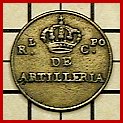 |
ROYAL CORPS OF ARTILLERY, 1802 PATTERN The Spanish Royal Corps of Artillery was given a new button device with a Royal Order of 22 July 1802 which, in addition to specifying a new uniform for the force, called for a flat button with a raised outer rim and bearing a device consisting of a royal crown with the motto "REAL CUERPO DE ARTILLERIA". This example, another of those from Spain featured in this section, is of die-stamped brass and bears the unusual backmark "WAKELIN Y TERRY / MAD/RID". (Were these British button makers working in Spain?) |
ROYAL CORPS OF ENGINEERS, 1797-1803 The Spanish Royal Corps of Engineers was first established in 1711. Traditionally, the engineers wore uniforms virtually identical to those of the Royal Artillery but with white and silver (rather than the artillery's yellow and gold) lace, trim, and buttons. From 1797—when the Royal Artillery was authorized its first unit-specific button device—until 1803, officers of engineers wore artillery buttons which were silver plated as a means of distinguishing these men from those of the artillery. The British-made button shown is very slightly convex, silver plated, and backmarked "WILLIAM ·• CALLOW • LONDON." Spanish artillery officers of the period wore the same button device but with a gold/gilt finish. |
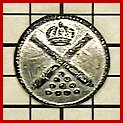 |
ROYAL CORPS OF ENGINEERS, 1803 PATTERN The Royal Corps of Engineers was given new uniform regulations in the military reorganization of 1802, and when unit-specific buttons were prescribed for the branch in 1803, the regulations called for "white" uniform buttons bearing a device consisting of a crown surmounting the motto "Real Cuerpo de Ingenieros". The convex example shown above is from Spain and is of two-piece laminated construction. The device is stamped on copper foil which is in turn laminated to and crimped around the edge of a brass core planchet. The original silver coloring of the button was imparted by a very thinly applied silver "wash" or via the application of a mixture of tin and mercury. |
Officer, Royal |
ROYAL SAPPERS AND MINERS, CA. 1802-1814 The Royal Regiment of Zapadores-Minadores was established as a two-battalion unit in September 1802. Though these troops comprised a distinct and autonomous force, they usually served in conjunction with the Royal Corps of Engineers. The button shown at right, from Spain, is a cast pewter enlisted issue example and is one of several known and very similar variations of marked buttons made for these troops. This example is flat with a plain, raised outer rim; slightly smaller, convex examples with beaded outer borders were also produced. This button's overall design and legend are typical of those issued to this branch, consisting of a Spanish royal crown surmounting the motto "RL ZAPADOS. Y. MINADOS." (Real Zapadores Y Minadores). |
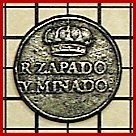 |
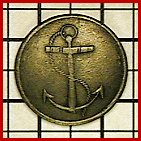 |
ROYAL NAVY, 1793-1795 PATTERN The first marked button for the Spanish Royal Navy was introduced in 1793 and was specified to be of "gold color, with an anchor." The example shown is from a private collection in Spain and is slightly convex, of cast brass, with an integrally cast drilled shank. After 1795, all Spanish royal forces' button devices included Spanish crowns over their unit or branch specific devices. |
|
|
|
| Above, Center:
First Condestable of Marine Bombaradiers and Artillery Brigades, 1797-1801 Source: Jose Maria Bueno, La Infantería Y La Artillería De Marina 1537-1931 (Malaga: Gráficas Summa, 1985), p. 21 |
||
ROYAL NAVY and ROYAL MARINE INFANTRY AND ARTILLERY On 29 November 1795, a new model button was prescribed for The Royal Navy and for Royal Battalions of Marine Infantry and Brigades of Marine Artillery (Spain's equivalent to the marines of other nations). This buttton's device consisted of a royal crown over the words, "REAL MARINA." The slightly convex Spanish-made officer's button on the left is crafted of heavily gilt copper with a conventional, brazed eye. The lightly gold washed, flat example at right is of British manufacture and is backmarked "GILT". This button pattern was superseded in 1802 by one with a Spanish royal crown above an anchor in the center for both the Royal Armada and the Royal Marine Infantry and Artillery. The fact that some of these "REAL MARINA" buttons have been recovered from such battlefields as Tudela, in which members of the Royal Marine Infantry and Artillery participated in 1808, proves that this then-outdated button form was retained in use by that branch until at least that date. It is likely that the Spanish Marine Infantry and Artillery desired to have a button device of their own, distinct from that worn by members of the Royal Navy. |
||
 |
1795-1802 NAVAL-MARINE CUFF/GAITER BUTTON This British-made and "GILT" backmarked "Real Marina" button is a diminutive version of the button device above with a beaded outer border. This example was recovered in Spain. |
1795-1802 NAVAL BUTTON VARIANTS These flat, British-made examples of the 1795-1802 royal naval services button pattern abbreviate the "REAL" of "REAL MARINA" with a shortened "RL." abbreviation. The use of abbreviated words on Spanish military buttons of this period was a common occurrence. Examples of the small button pattern shown have been recovered both in Florida and in Spain. |
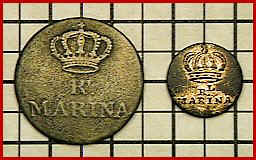 |
|
|
|
ROYAL NAVY and ROYAL MARINE
INFANTRY AND
ARTILLERY, 1802 PATTERN
The examples shown at left and right above are of solid cast brass have integrally cast, drilled shanks; the example at right exhibits the raised letters "L" and "C" on opposite sides of its shank. The smaller button shown at center is of two-piece construction, its stamped foil facing material being crimped around the edges of a central core planchet to which is brazed a conventional, looped wire eye. All conform to 1802 regulations for Spanish naval and marine infantry and artillery officers' duty dress uniform buttons. The example at left was recovered from southwest Alabama, while the other two specimens are from Spain. The design shown here replaced the 1795-1802 model shown above, although that earlier "REAL MARINA" pattern continued to see use by Spanish Marine personnel until at least 1808.
|
ROYAL NAVAL FORCES, Ca. 1812-1820s These buttons, like many of Spain's military goods of the Napoleonic period, are British-made. A nearly identical crown-over-anchor device was adopted by the British Royal Navy in 1812, although these Spanish-crowned examples of the period were made for use by Spain. This general style of military button design was produced in Britain for European and American military establishments through the 1830s. |
|
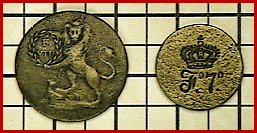 |
FERNANDO VII (Brass), Ca. 1808-1814 Several Spanish buttons marked with royal symbols and the cipher "F.7.o" or "F. VII" have been recovered in and beyond the study region, all of which are of ca. 1808-1815 British manufacture. The slightly convex example shown at left, made by Charles Jennens in London and probably an officer's button, displays the "FR. VII" cipher in raised Roman letters within a small wreath in the lion's paws; the other form (right), by London's Nutting & Son, is flat with the crown and "F°.7°" cipher incised. A Fernando VII line infantry regiment was raised in 1808 in Spain and dispatched to New Spain (Mexico) in 1818, but there is no known record of this unit having seen service in Florida. |
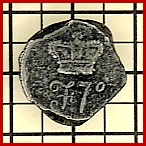 |
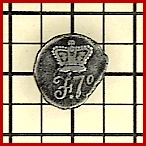 |
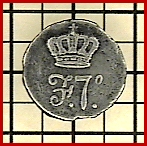 |
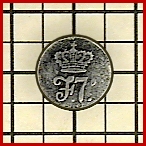 |
These pewter "F.7.o" buttons present, like their brass counterparts above, an interpretive challenge. Encountered in eastern Florida and Georgia, these are thought to have been general service issue patterns worn by Spanish regular or provincial royalist units. The coat and vest/cuff buttons at left bear no maker's marks and feature British crowns over the "F.7.o" cipher. The two examples at right, made and backmarked by well-known English button maker J. McGowan on Gerrard Street in London, feature Spanish crowns over the cipher design. The Spanish-crowned and backmarked examples were probably made shortly after the versions bearing British crowns and represent corrected variations of the same design pattern. |
|||
SECTION TWO: REGULAR FORCES
Few Spanish peninsular regular troops served in the study region for more than brief periods of time. Contingents of regulars participated in the sieges of Mobile (1780) and Pensacola (1781) during the American Revolution, but they returned home after their temporarily assigned duties were completed. During the period of Andrew Jackson's 1818-1819 invasion and occupation of Florida, a number of Spanish forces originally sent from Spain to deal with ongoing rebellions against Spanish rule in Latin America were dispatched from Cuba to Florida to "expel the North Americans." While this effort proved to be futile, elements of at least one unit—the Fourth, or Tarragona, Battalion of Light Infantry—apparently remained in the area until Florida's transfer to the United States in 1821. Additionally, one company each of the Málaga and Cataluña regiments served at St. Augustine from 1820 until that post was transferred to the United States in July 1821, although no buttons or other insignia from these troops have been yet encountered in that city.
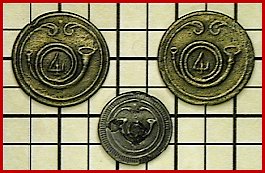 |
4th (TARRAGONA) BATTALION OF LIGHT INFANTRY, Ca. 1815-1821 (?) These buttons are of two-piece construction. Very thin stamped metal foil was crimped around the edges of a brass or copper core planchet, and the void between the layers was filled with solder to support the delicate facial design. These are known both without backmarks or with British "EXTRA RICH" or "SUPERFINE" "quality marks" on their core planchets. It is currently not known whether these were made in Britain or if Spanish artisans used British-made plain buttons and stamped and applied the foil facial elements to make the completed buttons. Examples of these have been found in both former East and West Florida including at a Spanish military occupation site on Alabama's Mobile Bay. The button design, which combines French influence with the hunting horn insignia for light infantry common to European and American armies of the period, conforms generally to 1821 regulations and an 1823 description of Spanish light infantry buttons which were apparently transcribed several years after the device actually came into use. Brass buttons were specified for this unit in 1815 and again in 1821. |
4th (TARRAGONA) BATTALION OF LIGHT INFANTRY, Ca. 1818-1821 The cast pewter examples shown were made in Spain and are backmarked "E. CAY Y COMPA " (coat size) and "ECAI. Y COMPA" (vest/cuff size). The example at top, center is a coat button cut down to vest/cuff size. These specimens, which do not conform to the 1815 or 1821 regulations calling for brass buttons for this unit, are believed to have been made soon before the unit was sent to the New World in 1818. The battalion was sent from Cuba to West Florida during the period of Andrew Jackson's invasion and occupation of that province. Officers of the unit were present at St. Augustine in 1820 to train the local militia there and members of the battalion also served as the Spanish governor's honor guard during the ceremonial transfer of Spanish West Florida to the United States on 17 July 1821, which marked the end of the Spanish colonial period in Florida. |
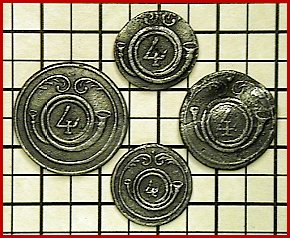 |
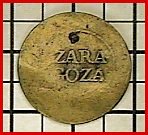 |
ZARAGOZA REGIMENT OF INFANTRY Though no record thus encountered provides details of this regiment's service in Florida, it was among the many regiments sent to the New World in 1818 in what proved to be a futile effort by Spain to reassert its military and civil authority over its independence-minded creole subjects in Latin America. The known examples of this regiment's buttons from Florida have been recovered in Pensacola. |
SECTION THREE: FIXED PROVINCIAL FORCES
In addition to the Louisiana Regiment of Infantry featured elsewhere at this website, several other Spanish colonial professional, veteran (fixed) provincial units—these all dispatched from their home base in Cuba—provided garrison forces for Florida's presidios during the 1790-1821 period: the Fixed Cuba Regiment of Infantry, the Fixed Infantry Regiment of Havana, and Havana's squadron of the Dragoons of America.
Other garrison troops, comprised of locally raised provincial and urban militia units, varied greatly in appearance, quality, and stability. No marked buttons or other unit-specific elements of metallic insignia have yet been reported that can be reliably attributed to use by any of these part-time militia forces, and it is probable that most or all of them used often old or obsolete reserves of unmarked Spanish colonial buttons and other metal accessories augmented by imported, salvaged, or other locally available supplies.
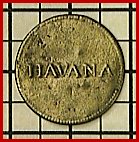 |
FIJO DE LA HABANA, Ca. 1805-1821 This two-piece, foil-laminated brass button substitutes the English "V" for the Spanish "B" in "Habana," a characteristic common to Spanish buttons made in Britain during the period. Its mode of construction is identical to the two-piece, foil-laminated 4th (Tarragona) Light Infantry buttons shown previously. Detachments of this Cuban veteran provincial regiment served with distinction in both East and West Florida until 1821. |
|
SOLDIER OF THE CUBA INFANTRY REGIMENT, REGULATIONS OF 1815 (Right) This
illustration from Los Uniformes del Estado Militar de España del Año 1815 by
Antonio Lanzano Lahoz and Luis Grávalos González depicts a Cabo Segundo of the
Fixed Cuba Regiment of Infantry in 1815. A virtual twin of this uniform was worn by
the Fixed Havana Regiment, but the jacket of the latter unit featured a red collar and
yellow facings and cuffs. In both instances, the regulations called for the use of botones
dorados (gold buttons), which, in practice, would have equated to gilt buttons for
officers and brass buttons for enlisted men. |
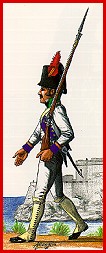 |
|
|
|
|
|
|
FIJO DE CUBA (One-Piece Varieties) Both Pardos y Morenos (Colored) and White detachments of the Regimiento de Infantería de Cuba served in the Floridas from 1790 to 1821. Several button varieties for this unit are shown above, all being of very thin, one-piece, die-stamped sheet brass with soldered copper or brass wire shanks. These delicate forms are of Spanish manufacture, the example at top, left having been struck on a slightly clipped planchet. These examples conform to 1796 Spanish regulations for fixed veteran unit regimental buttons. |
||
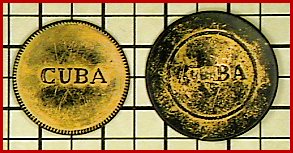
FIJO DE CUBA (Two-Piece Varieties)
These
buttons, whose stamped, gilded brass or copper foil faces are bent and crimped around the
edges of thin, flat, unplated brass planchets to which simple looped wire shanks were
soldered or brazed, were introduced during the terminal period of Spain's colonial
occupation of North America.
The relatively heavily gilt officer's example at left is
solder-filled between its foil and planchet elements with a beaded outer border
which appeared after 1802, while the
lightly gold washed, presumably enlisted issue button on the right, which has no solder
filling to support the foil face, retains the inner raised ring of its one-piece
predecessors shown previously. The fragile (and very impractical) nature of the latter
type's construction is demonstrated by the fact that the letters "CU" of
"CUBA" have been completely flattened, which, as the result of the
button's flimsy construction, could have been accomplished via the
exertion of mere finger pressure.
|
DRAGONES DE AMÉRICA, Ca. 1796-1805 Small numbers of the Havana-based Escuadrón de Dragones de América, who wore white metal buttons, were dispatched for service by 1809 to eastern Florida, where they remained to augment the garrison until 1821. This silver foil laminated and crimped, solder-filled two-piece officer's example was recovered from St. Augustine's Castillo de San Marcos in 1940. The illustration is of a color-enhanced replica, the original example having been darkened by nearly two centuries of oxidation. This button conforms to 1796 patterns prescribed for fixed veteran provincial units. |
DRAGONES DE AMÉRICA, Ca. 1805-1821 After 1802, the buttons of fixed or veteran units underwent a stylistic change. Beaded outer rim edges replaced the inset rings and inner rope borders of their 1796 pattern predecessors, and coat sized buttons were reduced in size. This example of a vest or cuff sized button of the Dragones de América conforms to these specifications, although its two-piece, silver foil-laminated construction is retained from the form shown above. The button shown here was recovered in Savannah, Georgia; its presence in that locale remains to be explained. |
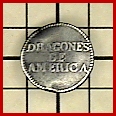 |
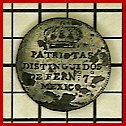 |
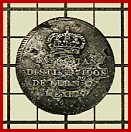 |
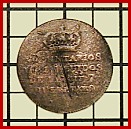 |
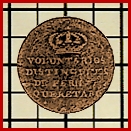 |
MEXICAN ROYALIST BUTTONS, Ca. 1808-1814
During Spain's War of Independence against the occupation forces of Napoleonic
France, numerous royalist regiments were raised in the New World and manned by
local criollo (creole)
officers and men. Most of the new units were equipped partially or wholly by
Spain's British allies.
Some
of these regiments were made up of first-rate troops equal or superior in
quality to fixed veteran forces already serving in Spain's colonial empire. Such
a unit was the Patriotas Distinguidos de Fernando 7o
de México (Distinguished Patriots of Fernando VII of
Mexico), formed in 1810 in Mexico City. Two buttons of this regiment — one
Sheffield silver plated and one silver foil laminated — are shown at left,
above.
Local militia units, who were occasionally quite well
equipped but who were far less well led and disciplined than their Distinguido
counterparts, were also raised between 1808 and 1810. These forces were
generally referred to as "volunteers" rather than as
"patriots" in terms of their official unit designations. Two buttons
of the Voluntarios Distinguidos de Fernando 7o de
Querétaro, one of these militia regiments raised in a state
north of Mexico City, are shown above at right. Both were originally gilt in
finish. All of the buttons shown were manufactured in Great Britain.
After brief terms of loyal service to Spain and the Spanish
royal house, many of these units and their leaders switched allegiances
to fight for independence from their mother country. These men, freshly armed
and equipped by Spain and Britain alike, formed a formidable military nucleus
for wars of rebellion that would ultimately spread throughout Spanish America.
Examples of "Distinguished Patriots" buttons have
been recovered in Texas, Louisiana, and Florida. Examples of "Distinguished
Volunteers" buttons have been encountered in Texas, Mississippi, and at a
site which has also yielded numerous pewter Spanish "F.7.o"
buttons (see examples shown previously) near Darien, Georgia. The presence of
the men who wore these buttons so far from home and often well within United
States territory is presently unexplained. It is believed that these troops were
engaged in covert operations in southeastern North America, but the nature and
outcome of their mission remain to be studied and defined.
SECTION FOUR: OTHER BUTTON TYPOLOGIES
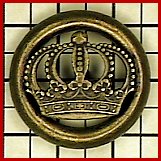 |
SPANISH OFFICER'S COLLAR BUTTON (?), Ca. 1808-1814 Recovered from spoil dirt from Fort Condé/Fort Charlotte/Fuerte Carlotta in Mobile, Alabama, this large button consists of a cast and die-stamped Spanish crown with a long, cotter pin-like brass wire eye brazed to its back, which element is in turn very delicately brazed to a tubular, hollow brass sheet metal outer rim. Although several of the outer rims alone have been found in both Mobile and Pensacola, this is the only complete example available for illustration here. This is strongly believed to be of British manufacture, but its use as an officer's collar device remains speculative. |
|
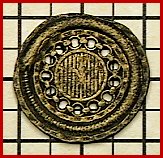
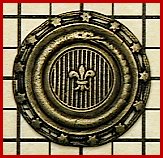
"OUROBOROS" BUTTONS
The complex designs of these
intricately and expertly fashioned Spanish-made cast brass buttons contain symbolic
elements which require further interpretation but which clearly allude to the United
States during its early national period as well as to the royal house of Bourbon.
The device of the button on the left, which was recovered from
northwest Florida, includes a representation of Ouroboros (also spelled
"Oroboros"), a mythical serpentine symbol of destruction, renewal, and the
cyclicism of nature. In this case, Ouroboros appears in the form of the
rattlesnake, whose species are found only in the New World. Within the encirling serpent
is a chain with 13 perforated capital links, which, in turn, surrounds a central design
comprised of a diminutive and weakly defined fleur de lis on a circular
background with 13 lines in its field.
The beautifully crafted example shown above at right, recovered
from the vicinity of Savannah, Georgia, features 13 six-pointed stars on an outer border
with 13 perforated bar links surrounding a cast and separately applied Auroboros
serpent, again in the form of a rattlesnake. This button's central emblem also consists of
a field with 13 lines upon which is prominently placed a Bourbon lily in high relief.
While probably not military buttons per se, these may
be early patriotic or "public relations" buttons made in Spain to commemorate
friendship between the United States and Spain. Both examples are believed to have been
made during the ca. 1785-1800 period.
ORNAMENTAL FLEUR DE LIS BUTTON Like the "Ouroboros" button shown above, this example is expertly fashioned of lost wax cast brass with a stylized Bourbon lily in its center. Though its original brazed wire eye is absent, the manner in which it was attached remains clearly visible on the button's back. Its attributes suggest that it is of French or Spanish manufacture of the ca. 1785-1800 period, but its specific interpretation awaits further research. It is not presently believed to be a military issue button, but rather one worn by a prominent citizen or official. |
|
|
ROYAL RIDING CLUB BUTTON, Ca. 1820 Recovered along the Georgia-Florida border, this small, flat, silver-plated copper and probably British-made button has a "split anvil" seam on its reverse face and was made for use by a member of the Real Maestranza de Caballería de Sevilla (Royal Riding Club of Seville Cavalry). Deceptively military in its appearance, this button was in fact made for a member of one of several similarly named elite, honorary cofriadías (brotherhoods or associations) of nobles established in Spain's major metropolitan centers during the 1820 period by King Fernando VII. Embodying another of several interpretive challenges included on this page, it is hypothesized that this was worn (and lost) by a member of this group visiting the area during the period of East Florida's transition from being a Spanish province to becoming a territory of the United States. |
Acknowledgments:
Jim R. Baldwin; Chris Bennett; Paul Blatner; Castillo de San Marcos
National Monument; Alfred Dachenhausen; Bob Edmondson; T. Scott Freeland; Eugene
Gruenewald; Tim Hampton; Dr. H. Louis Hill, Jr.; David Karstaedt; Bill R. Logan; Brett McWilliams; Tom
Matthews; Pensacola Historical Society; John R. Powell; John and Rosemary Sanders; Michael
O. Smith; Southeastern Archaeological Center, National Park Service; Arthur, Imogene, and Samuel Standard;
and Warren K. Tice.
Special recognition is extended to Mr. René Chartrand and Sr. Luis Sorando Muzás for their invaluable assistance in the interpretation of the materials exhibited here. Sincere thanks are also extended to Sr. Sorando for his generous willingness to share examples of Spanish military buttons from his extensive personal collection for use in this section.
![]()
Go Directly to Luisiana
Regiment of Infantry Page
For More Illustrations of Marked Spanish Buttons